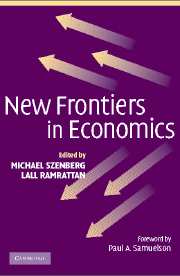Book contents
- Frontmatter
- Contents
- List of Contributors
- Foreword by Paul A. Samuelson
- Preface
- Acknowledgments
- Introduction
- PART I INFORMATIONAL BEHAVIORAL ECONOMICS AND FINANCE
- PART II MACROECONOMICS AND PUBLIC POLICIES
- PART III INTERNATIONAL TRADE AND DEVELOPMENT
- 7 Economic Theory and the Interpretation of GATT/WTO
- 8 What's New in Development Economics?
- PART IV CONTRACTS, LAW, AND GAMING
- Author Index
- Subject Index
- References
8 - What's New in Development Economics?
Published online by Cambridge University Press: 06 July 2010
- Frontmatter
- Contents
- List of Contributors
- Foreword by Paul A. Samuelson
- Preface
- Acknowledgments
- Introduction
- PART I INFORMATIONAL BEHAVIORAL ECONOMICS AND FINANCE
- PART II MACROECONOMICS AND PUBLIC POLICIES
- PART III INTERNATIONAL TRADE AND DEVELOPMENT
- 7 Economic Theory and the Interpretation of GATT/WTO
- 8 What's New in Development Economics?
- PART IV CONTRACTS, LAW, AND GAMING
- Author Index
- Subject Index
- References
Summary
INTRODUCTION
This essay is meant to describe the current frontiers of development economics, as I see them. I may as well throw up my hands at the onset and say, There are too many frontiers. In recent years, the subject has made excellent use of economic theory, econometric methods, sociology, anthropology, political science, and demography and has burgeoned into one of the liveliest areas of research in all the social sciences. And about time, too: the study of economic development is probably the most challenging in all of economics, and – provided we are patient about getting to “the bottom line” and the “policy implications” – it can have enormous payoffs.
Fortunately, considerations of space allow me to use brevity as an excuse for selectivity. So rather than attempt an exhaustive review of several areas, I would like to concentrate on a few methodological points around which recent literature appears to have clustered. More than anything else, I want to underscore a certain way of thinking about development that has become increasingly influential over the last few decades, one that is changing and will continue to change the face of research in this discipline.
The main trend I would like to try and document is a move – welcome, in my opinion – away from a traditional preoccupation with the notion of convergence. This is the basic notion that given certain parameters, say savings or fertility rates, economies inevitably move toward some steady state.
- Type
- Chapter
- Information
- New Frontiers in Economics , pp. 235 - 258Publisher: Cambridge University PressPrint publication year: 2004
References
- 1
- Cited by



